Livebearers are some of the most common and popular fish in the aquarium trade.
The name “livebearer” tells you one aspect of what makes these fish even more interesting than others: rather than laying eggs, the mothers raise their young within until they’re strong enough to swim on their own.
Similar to a mammal, the male impregnates the female internally. The female then grows increasingly swollen as the babies develop.
These very well developed young have a greater chance of survival in the wild compared to other species!
Fortunately, these fascinating fish are inexpensive, easy to care for, and peaceful additions to any community aquarium.
There are several livebearers that you’ll find at just about any pet store or online fish store; this article covers the most common freshwater livebearers in today’s markets!
Types of Common Freshwater Livebearers
Here are a few of our favorite livebearers for freshwater aquariums:
Guppy (Poecilia reticulata)
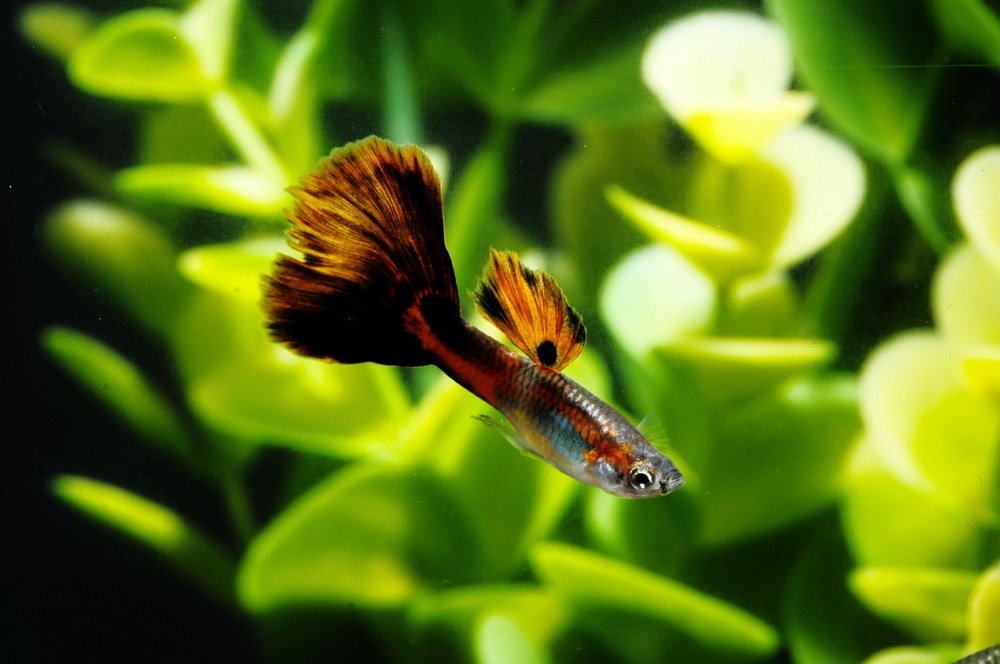
Native to the Carribean coastal regions of South America and a few nearby islands, Guppies are opportunists with a special taste for mosquito larvae and other freshwater invertebrates.
As a result, Guppies have been introduced to waters across the world to help control mosquitoes and the diseases they often carry.
Having been bred in aquaria for decades, Guppies are some of the easiest fish on the market to care for, making them a popular first livebearer for beginners.
They will eat nearly anything offered and will tolerate a wide range of water parameters. They generally prefer moderately warm temperatures of 75-78 degrees and slightly alkaline water.
Guppies live up to their other name (Million Fish) in their breeding habits. Females mate with multiple males to ensure virility and rapid gestation of each brood (polyandry).
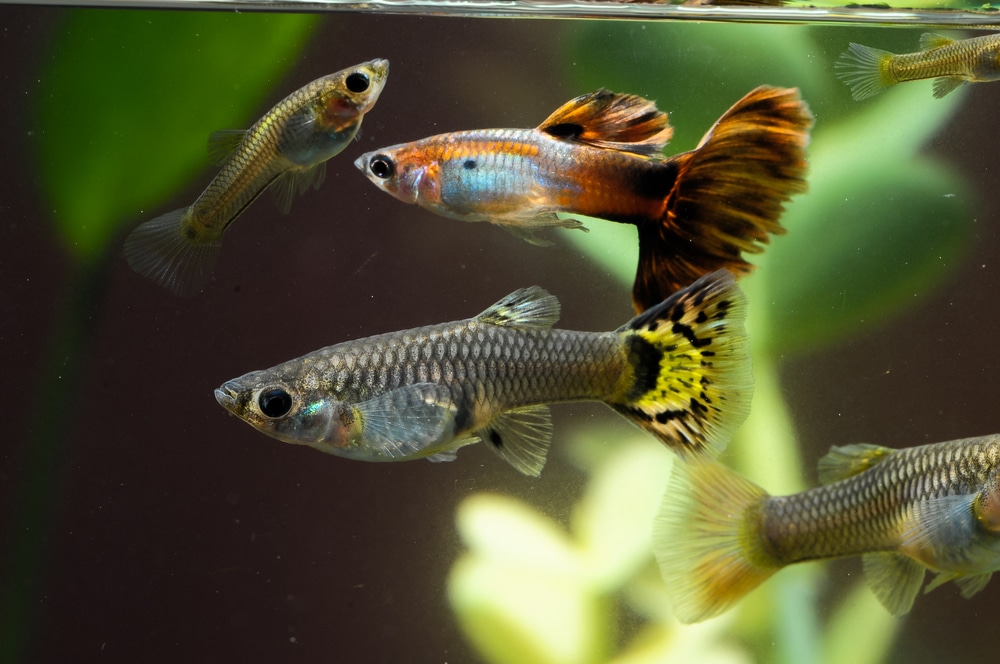
Their preference for diverse partners is a major reason why even wild guppies are so diverse in color and form compared to most fish.
Guppies also eat less vegetation compared to other livebearers. Small frozen and live prey like daphnia, mosquito larvae, bloodworms, and brine shrimp go a long way towards better color and health.
As nearly all fishkeepers know, Guppies come in an incredible array of forms and colors. Mottled reticulated, spotted cobras, swordtail and lyretail forms are just a few of what you’ll find in most stores. Guppies are especially sociable and prefer being kept in groups of 6 or more.
Guppy Summary
- Can be Kept in Tanks as Small as 5 Gallons
- Very Hardy and Easy to Feed
- Moderately Warm, Alkaline Waters
- Huge Variety of Colors and Fin Shapes
Endler’s Livebearer (Poecilia wingei)
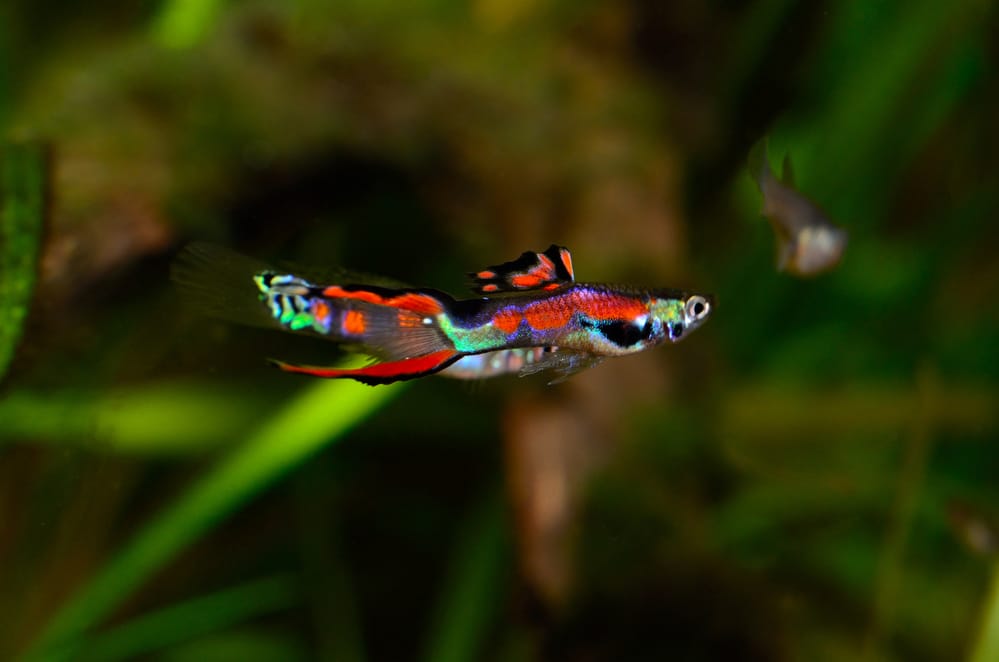
This close cousin looks like an even more vividly colored wild-type Guppy. With bright neon green and red stripes and spots, these tiny livebearers are becoming popular for nano fish tanks and planted tanks with cherry shrimp and other peaceful, delicate inhabitants.
Even smaller than most guppies, Endler’s Livebearers rarely grow larger than an inch; females will just clear that while males max out at ½-¾ of an inch.
As close Guppy cousins, they will readily interbreed with one another, making separate tanks a good idea if you intend to raise and give away the offspring.
Endler’s Livebearers are just as hardy as Common Guppies, though they don’t come in nearly as many colors and fin shapes. Some varieties like cobra and fantail Endler’s Livebearers directly resemble Common Guppy breeds.
These tiny fish are food for a lot of creatures in the wild and prefer being kept in schools of 6 or more for a sense of safety.
Mollies (Poecilia sp.)
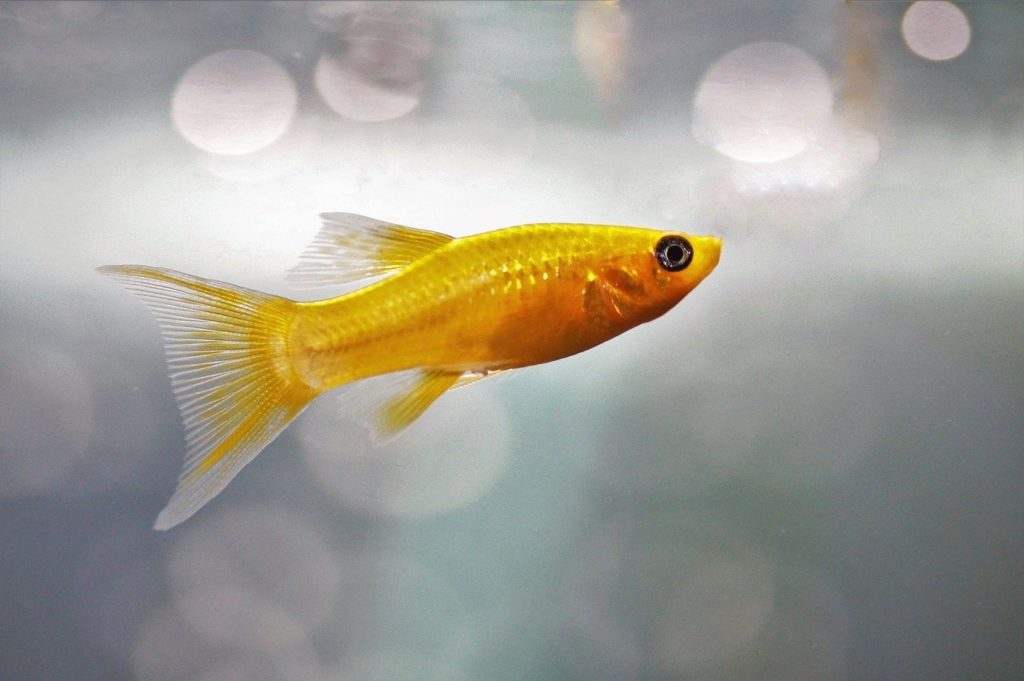
Although closely related to guppies (Poecilia reticulata), mollies are the livebearer that looks least like them.
Significantly larger than their diminutive cousins, mollies are salt-loving livebearers native to the warmer portions of the Carribean coast along North and South America.
While all livebearers prefer a touch of salt and veggies in their diets, mollies thrive on both. They are commonly found in brackish and even saltwater environments throughout their rage.
Mollies have a taste for filamentous algae and soft-bodied plants like Elodea. Providing blanched soft greens like zucchini is paramount for good color and eventual breeding.
As a general livebearer rule, males are showier than females. While in terms of color this is less true for mollies, males carry showy dorsal and tail fins that they use in contests of dominance and sexual displays.
Common Molly (Poecilia sphenops)
Of the three common molly species in stores, this is the most frequently seen species. Like all livebearers, they are often labeled by their strain rather than a single name. G
old Dust Mollies are spangled in midnight black and shocking, reflective gold. Dalmation Mollies (a name shared with some Sailfin varieties) are spotted in white and black. And a few other varieties exist, most variations on the black, gold, and spotted theme.
Having been captively bred for hundreds of generations, Common Mollies are the easiest to keep of all the Molly family.
They are the most tolerant of varying water quality, don’t suffer much from lack of salt, and will happily eat anything offered. They will also breed readily compared to the others.
Sailfin Molly (Poecilia latipinna)
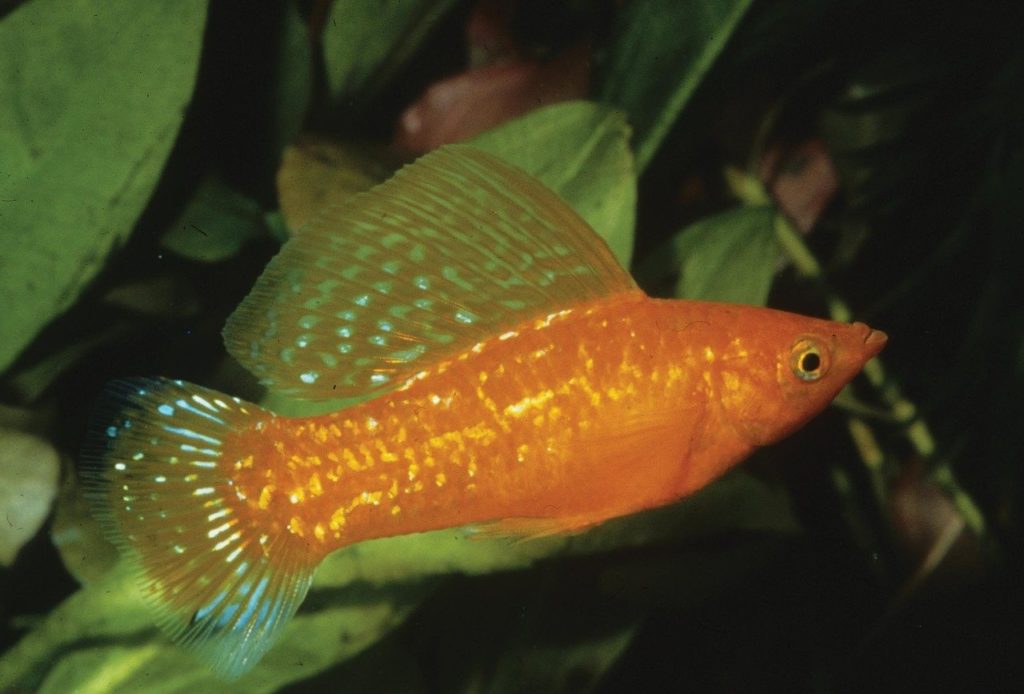
Sailfin Mollies are the second most commonly found Molly species. Found in coastal brackish and salt water from North Carolina along the coast all the way to Southern Mexico, Sailfin Mollies are hardy in terms of water temperature but demand the addition of salt to their water.
While they tolerate fresh water, they become far more sensitive to parasites and poor water quality. Popeye, dropsy, ich, fungus, and other conditions manifest easily when Sailfin Mollies go without salt.
Sailfins also happily munch on vegetarian food. Spirulina flakes are a great addition if you don’t care to provide fresh greens in some form.
As one of the largest livebearer species, Sailfins can grow to 4-5 inches long but usually max out at 3 inches.
The males have splendid dorsal fins full of color that they use like banners to showcase their fitness and attract females.
Yucatan Molly (Poecilia velifera)
Yucatan Mollies are another showy Molly species and some of the largest livebearers in the Poecilia genus. Sometimes Yucatan and Sailfin Mollies are confused for one another.
If not fully grown or sourced from the wild, the best way to tell is to get a count of the dorsal fin rays. Sailfin Mollies have 15 or less, while Yucatan Mollies approach 20 rays. Given how much hybridization has occurred over the years, it’s not a sure rule unless dealing with wild-caught specimens.
Most of what was said about Sailfin Mollies also applies to Yucatan Mollies. As the largest commonly found livebearers, they need a minimum of 30 gallons of space. Males can reach up to 6 inches, though are usually smaller. Females can reach 6-8 inches, however!
Native to coastal waters around Mexico’s Yucatan Peninsula, these Mollies don’t handle the cold well. Warm waters of 77F and above are mandatory for good health, as well as liberal doses of salt.
While a few color varieties exist, they are usually the result of crossbreeding with their close cousins, P. latipinna and P. sphenops. Most wild Yucatan Mollies are a reticulated orange color mixed with silver and blue.
Molly Summary
- Hard Alkaline Water
- 1 Tsp/Gallon of Aquarium Salt or Brackish Water Preferred
- Not as Easy to Breed as Other Livebearers
- Vegetarian Food Necessary
Platies (Xiphophorus sp.)
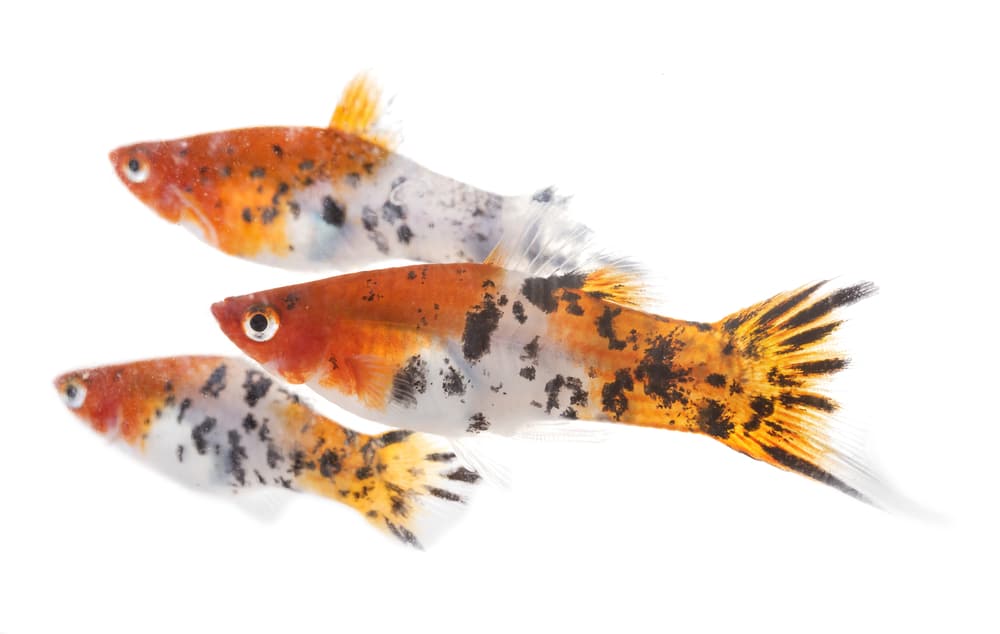
Platies can almost compete with Guppies as the first fish for many new aquarium hobbyists. Coming in a wide array of colors and a little larger than Guppies, these punchy livebearers are a great addition to any community or species tank.
Native to Mexico and Central America, Platies like but don’t require salt the way Mollies do. As members of the genus Xiphophorus, they are especially closely related to Swordtails (Xiphophorus hellerii) and occasionally interbreed with their larger cousins.
Male Platies are smaller than females but not nearly as much compared to other livebearers. They are also quite tolerant of other males and don’t try to dominate each other the way other livebearers do.
Unfortunately, this can mean males will “school” as they chase unwilling females around a tank. It’s best to have 2 females for each male, to ensure they all have a chance to escape his attention!
Southern Platy (Xiphophorus maculatus)
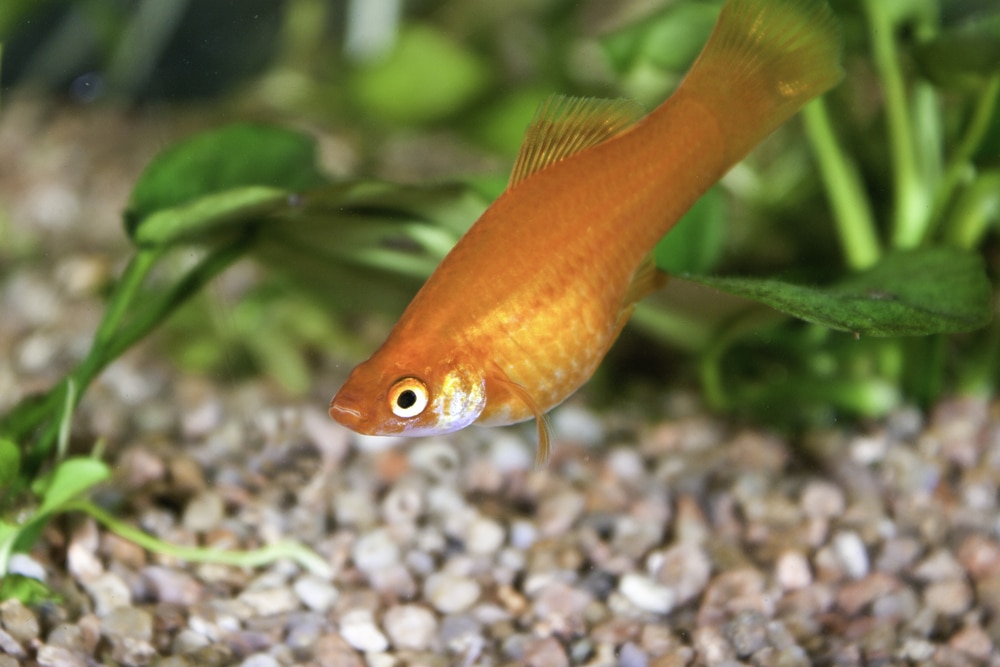
Southern Platies are the standard Platy you see in nearly every aquarium store in the world. Maculatus comes in hundreds of different color forms, with black, golds, reds, blues, sword tailed, and hi-fin forms, just to name a few.
Having been captive bred for decades, Southern Platies are extremely hardy and will tolerate temperatures from 69-80F and even slightly acidic waters.
Like all livebearers, however, they prefer slightly alkaline water, moderately warm temperatures (75 degrees), occasional vegetables, and a touch of salt for optimal health. 10 gallon tanks are a good starting point for Platy keepers.
Southern Platies are as easy to breed as Guppies and with as much hybridization that’s occurred over the years, even two parents that look alike may have babies that come in a confetti of different hues.
Variable Platy (Xiphophorus variatus)
Variable Platies are a bit less common than Southern Platies but are still easy to find. These livebearers are slightly thinner than the chunky Southerns but also max out at around 2 inches.
Despite the name, Variable Platies don’t come in quite as many colors as Southern Platies; most color varieties are a mixture of gold, red, and black.
Variables are just as easy to keep as Southern Platies and will even interbreed with their close cousins, including Swordtails, for intriguingly patterned offspring.
Platy Summary
- Very Hardy but Prefer Moderate Temperatures and Alkaline Water
- Medium Sized Livebearers
- Easy to Breed
- Will Eat Anything
Swordtail (Xiphophorus hellerii)
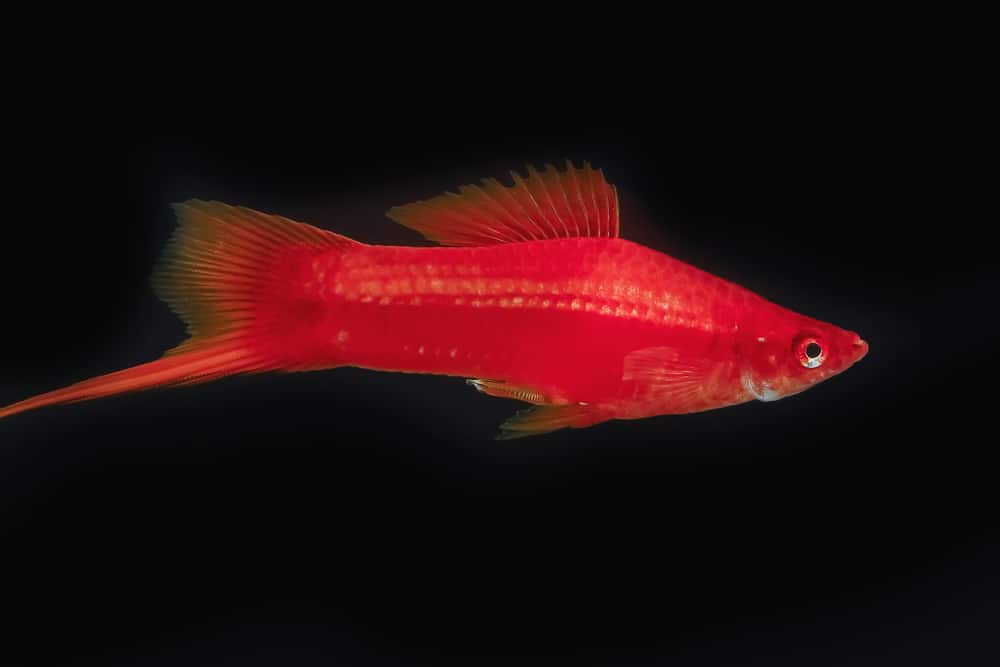
Close cousin to the Platies, Swordtails are native to Mexico and Central America. The most common species is the Green Swordtail, which does have a light greenish hue in nature. Thanks to captive breeding, Swordtails come in a wide array of colors, with reds, blacks, golds, and blues part of the potential palette.
Double Sword and even Lyre-finned Swordtails also exist, allowing them to compete even with Sailfin Mollies for splendor while being far easier to keep.
Swordtails are especially easy to tell male from female: only males have the showy extension of the tail fin that gives them their name. Like all livebearers, females are also usually less colorful and slightly larger. Swordtails are showier than platies and slightly larger at 3-4 inches, yet are also as easy to keep and breed.
While varieties of the Green Swordtail are found in pet shops around the world, wild-caught species occasionally appear in specialty stores.
Even wild swordtails tend to be easy to keep and breed but considering their rarity, never mix them with common Swordtails, lest they produce hybrid young you shouldn’t sell.
Swordtail Summary
- As Showy as Mollies but Much Easier to Keep
- Medium Sized
- Easily Bred
- Non-Picky Eaters
Caring for Livebearing Fish
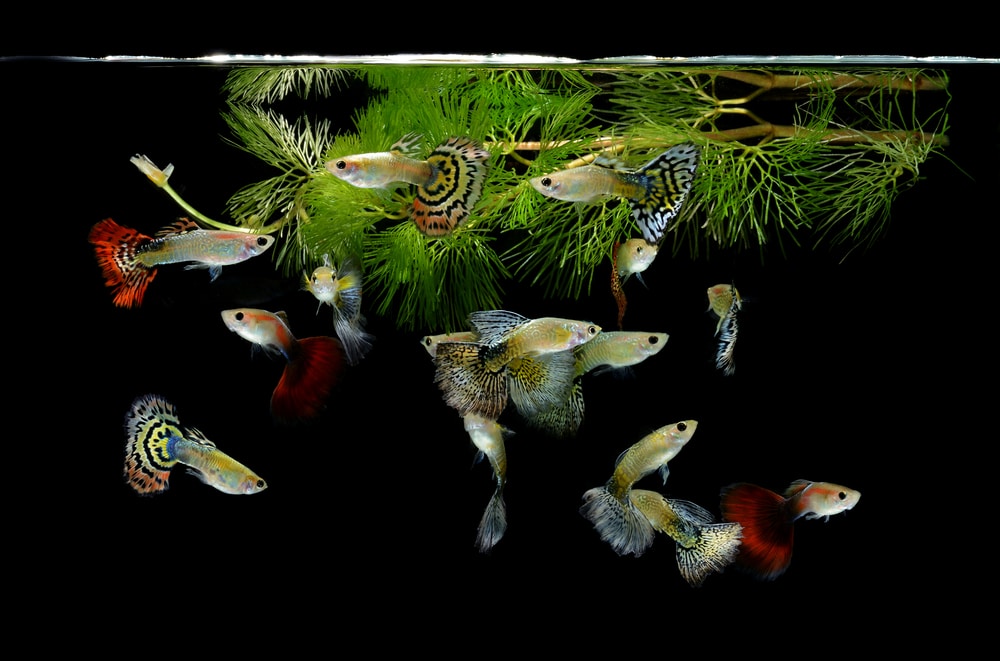
While some of the least demanding of all aquarium fish, freshwater livebearers have some characteristics worth studying:
Aquarium Size
Livebearers vary tremendously in size; male Endler’s Livebearers can be as small as ½ an inch while Yucatan Molly females reach 8 inches in length.
As a general rule, we always want to give fish as much space as we can afford.
Larger tanks are actually easier to maintain than small ones because they have more water. More water volume means the tank is less sensitive to sudden changes in temperature, pH, salinity, ammonia, and other parameters.
Guppies and Endler’s Livebearers can live comfortably in tanks as small as 5 gallons with 10 being much more comfortable for groups.
Platies, Swordtails, and Common Mollies enjoy 10 gallons as a minimum, with 20 being better for Swordtails as they mature. Sailfin and Yucatan Mollies should be kept in tanks of 30 gallons or larger.
Water Quality
Since livebearers come from the same general region (warm coastal Atlantic/Caribbean waters of North and South America), they share preferences in a lot of ways.
Warm temperatures of at least 75 degrees F, alkaline waters (pH higher than 7), and live plants for additional oxygenation go a long way to keeping them happy and willing to breed.
All livebearers also like salt in their water to some degree. Guppies, Platies, and Swordtails are the least needy, while Mollies require.
A teaspoon of non-iodized aquarium salt per gallon is a good amount for the first three, with mollies loving as much as you care to add, up to full ocean salinity.
Mollies are sometimes even be kept as algae eaters for reef aquariums!
Tankmates
All four major groups of livebearers are peaceful and non-combative with other fish. They make great additions to any sort of peaceful community tanks.
Keep in mind if you decide to add aquarium salt that the other species are also tolerant of salt.
Many fish, especially those from soft, acidic waters, are very intolerant of aquarium salt at the levels livebearers love.
Breeding Livebearers
Livebearers are some of the most rewarding fish you can own if you want to raise babies.
They are easy to find, easy to tell the sexes apart, obvious when they’re pregnant, and give birth to large, well developed offspring that will eat almost anything. With the well mixed gene pools of most captive-bred livebearers, the babies can come in nearly any variety, particularly Guppies and Platies.
Males vs. Females
Male livebearers are always smaller and showier in color. They all also have a gonopodium; a tubular anal fin used to impregnate females internally. Females are larger, usually less intensely colored, and have a normal, fan-shaped anal fin.
Notice the tube-like gonopodium of the smaller Endler’s Livebearer male, extended forward as he tries to copulate. Also the fan-shaped anal fin of the much larger, drab colored female.
Considering livebearers like Guppies not only mate with several males but will delay gestation and even store sperm from previous mating from the fittest partners, it can be challenging to predict when broods will develop.
As a rough rule of thumb, livebearers can reproduce every 3-6 weeks when in optimal health.
The number of babies ranges from 20 up to 100 at a time; how swollen the female’s belly is gives you some indication of how heavy she’s carrying.
Breeding Signs
Another sign to watch out for is the gravid spot. This dark spot is most obvious in smaller livebearers females that are less brightly colored, like Guppies and Platies.
This dark area near the base of the anal fin shows where the young fry develop.
The gravid spot grows in size and changes color as the babies develop within. Heavily pregnant females may have skin stretched so tight the eyes of the young can be seen through the spot and her scales!
The Birthing Setup
When the timing seems right, moving the pregnant female to either a separate tank or breeding trap is the best way to ensure the other fish don’t devour the helpless fry. Even their mother will forget after giving birth and consider them food if found in the aquarium!
Breeding traps come in plastic varieties with grates where the young can fall through upon birth as well as simple mesh traps.
Most livebearers give birth either at dawn or dusk, a natural adaptation that gives their young the best chance of survival.
Feeding the Fry
Livebearer young are relatively large compared to other aquarium fish species.
While finely crushed flake food powder can be offered, tiny frozen and live food like baby brine shrimp and water fleas are more likely to be accepted and provide better nutrition.
The crushed yolk of hard boiled eggs is another great choice – but in tiny amounts! While especially high in fats and protein, egg yolk fouls aquarium water incredibly fast.
Conclusion
While there are several types of common freshwater livebearers, the various species of Guppy, Molly, Platy, and Swordtail are the ones you most often see.
These livebearers come in tremendous variety; every color of the rainbow, dwarf varieties, and fin extensions are all part of the show they provide. And most of them are extremely hardy and rewarding to breed!
If you haven’t already, give freshwater livebearers a try sometime!

